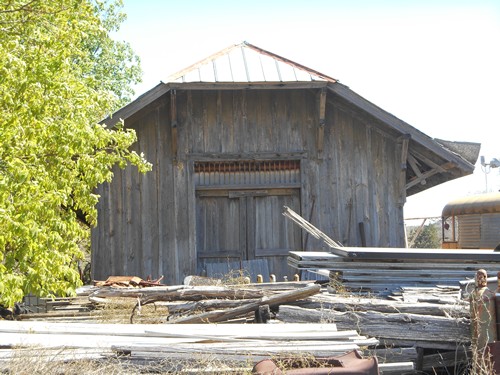Books by
Michael Barr
Order Here: |
|
|
A
visitor to Waring might think the lights are on, but nobody's home.
That's because Waring,
near Comfort
in Kendall County,
is 6 miles north of I-10 and doesn't get many tourists. But Waring
was once a busy place and a popular destination for travelers.
The area around Waring has had some geographic importance for centuries.
Waring lies northwest of Spanish Pass - a narrow path through the
hills and a natural gateway into the Hill
Country. In the 1870s the Overland Stage built a remount station
there. A road through the area was one of the main thoroughfares
from San Antonio
to the communities along the
Pedernales and the
Llano.
The town of Waring began in 1887 when engineers plotted a route
for the San Antonio and Aransas Pass Railroad between San
Antonio and Kerrville.
The route went near Boerne,
through Spanish Pass and into the Guadalupe River Valley.
An Irishman named Robert Percival Maxwell Waring owned a ranch along
the
Guadalupe, and he donated land to the railroad for a whistle
stop and a town site. He named the town Waringford after his ancestral
home near Belfast, in Northern Ireland. Most people called the town
Waring, and in 1901, the short name became official.
The railroad built a depot at Waring. On October 9, 1889, Mr. Waring
donated lot #1, Block 15, for a school. The building still stands.
In 1892, August Offer came to Waring via Sisterdale.
Offer, a man of some means, saw economic opportunity in the new
railroad town. He built a store and a saloon near the depot.
|
 |
Waring school
outhouse
Photo courtesy Michael
Barr, March 2017 |
Waring General
Store
Photo courtesy Michael
Barr, March 2017 |
Waring General
Store side view
Photo courtesy Michael
Barr, March 2017 |
|
No one worked
harder than August Offer to put Waring on the map. He built a cotton
gin. He dammed up the Guadalupe
and built a grist mill. He built a lumber yard and a livery stable.
He started the first telephone company in the Hill
Country. He was the postmaster. He built a camp yard - a kind
of frontier truck stop and RV park - for freighters and travelers
to spend the night. In his spare time he ran two farms.
With road traffic and business from the railroad, Waring started
to grow. In time the town had several stores, a saloon, a dance
hall, a hotel, a boarding house and a rock quarry. The San Antonio
City Hall was built of stone quarried at Waring and shipped to San
Antonio by rail.
|
San Antonio
City Hall built of stone quarried at Waring
Postcard
courtesy www.rootsweb.com/ %7Etxpstcrd/ |
Courtesy
Texas Transportation Museum, Hugh Hemphill, Director.
www.txtransportationmuseum.org |
|
Waring became
the first real convenience stop after the railroad left San
Antonio for Kerrville.
The train usually spent 15 to 20 minutes in Waring, coming and going
- plenty of time to get a beer and do a little shopping.
Then city folks discovered the beauty of the Guadalupe River Valley
and turned Waring into a tourist town. Vacationers and weekenders
came to fish and swim in the river. Others came just to relax and
enjoy the fantastic scenery. The Guadalupe,
its jade green waters shaded by a canopy of tall Cypress trees,
is one of the most beautiful rivers on earth.
In 1917 the Fredericksburg
and Northern Railroad laid tracks from Fredericksburg Junction,
near Waring, north to Fredericksburg.
Soon after that the highway through Spanish Pass and Waring was
widened and improved.
|
|
|
Click on image
to view map
Courtesy Texas Transportation Museum, Hugh Hemphill, Director.
www.txtransportationmuseum.org
|
|
But along the
way, Waring's destiny as a boomtown suffered a series of setbacks.
On February 2, 1895, R. P. M. Waring died of pneumonia at his old
home in Waringford. He had been called back to Ireland to administer
the large estate of a brother who had recently died.
Then workers built a new highway, between Fredericksburg
and Comfort,
bypassing Waring by several miles. The Old San Antonio Road was
the first paved highway running north into Gillespie
County.
August Offer saw the handwriting on the wall. He moved to San
Antonio in 1922.
Waring still had the train, but in time it went away - put out of
business by cars, trucks, good roads and cheap gasoline. The last
train to Fredericksburg
came through Waring in 1942. Rail service between San
Antonio and Kerrville
stopped in 1970.
Waring has been hidden away ever since, waiting quietly to be rediscovered.
© Michael Barr
"Hindsights"April
1 , 2017 Column
Sources:
"The New Town of Waringford," The San Antonio Daily Express, February
14, 1888.
"Death of R. P. M. Waring," The Galveston Daily News, February 7,
1895.
"Ghost Town Lives," San Antonio Light, September 7, 1958.
"Accident Fatal to August Offer," San Antonio Express, April 23,
1932.
The Handbook of Texas.
|
|
|
